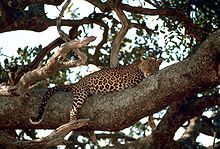Wikijunior:Big Cats/Leopard

The leopard is the champion athlete of the cat world. Most big cats can pull with five times as much force as the same weight of human athletes. The leopard can pull seven times as hard. It would take three Olympic class weightlifters merely to achieve a draw at tug of war with one 100 pound leopard. This amazing strength is demonstrated when a successful hunter scrambles up the side of a tree with a full grown antelope in its jaws to eat in peace.
The leopard gets its name from the ancient Greek words for "lion" (leon) and "panther" (pard).
Where do leopards live?
[edit | edit source]
Leopards live in the Middle East, parts of Asia, and Africa. This means they live in more places than any other big cat. Leopards spend a lot of time in trees, often sleeping draped over a branch. They will even pull entire prey animals up into the branches where they can eat without having to fight off other predators trying to steal their food.
What do leopards look like?
[edit | edit source]
Leopards are usually 6.5-10 feet (2-3 m) long, including 23-43 inches (58-110cm) of tail, and weigh about the same as a human or a large dog, 65-155 pounds (30-70 kg). They stand 17.5–30.5 inches (43-78 cm) tall. Female leopards are usually only two-thirds the size of male leopards.
A leopard's coat is short and sleek. Depending on where it lives, a leopard's coat can be a pale straw color, grey, gold-ish, or black. All leopards have black spots. Because the fur in a leopard's spots is thicker and more coarse, they can be felt as well as seen.
Black leopards are sometimes called panthers, and they were once thought to be a separate species. Though they are all black, they still have the black spots that leopards are famous for. On black leopards, these spots are only slightly darker than the surrounding fur, but under very bright light, they stand out from the lighter, somewhat purplish, background fur.
What do leopards eat, and how do they catch their prey?
[edit | edit source]Leopards tend to eat antelopes and similarly sized herd animals. They avoid the larger herbivores, such as water buffalo, because the larger beasts can only be safely captured by groups of animals that hunt in teams, such as lions. Leopards also eat smaller animals including rodents, rabbits, and even large insects. Some have been known to eat Nile crocodiles, which are powerful reptiles!
They are known to kill and eat dogs, so those persons who bring a dog into leopard country are advised to cage the dog so that it does not become food for leopards.
Fun facts
[edit | edit source]- In captivity, leopards are the most temperamental of the large cats and can be difficult to handle. While they can be affectionate, they cause an unusually large number of animal-related injuries among caretakers in zoos, circuses, and animal care centers.
- It is built like and acts much like a house cat, so anyone fascinated by the big cats might as well have a house cat that behaves much the same as a leopard -- except that a house cat can't hurt you a lot when it scratches or bites.
- One of the funniest movies ever made was one called Bringing Up Baby. It is old -- it was made in 1939 and it is in black-and-white -- and it stars a leopard named "Baby" that creates problems for the great human movie stars Cary Grant and Katherine Hepburn. (If you don't know who Cary Grant and Katherine Hepburn are, then ask an adult over 50. Those were two of the greatest movie stars ever).
But don't ask for a pet leopard. A little house cat or a dog of any size is far safer.
For more information
[edit | edit source]- Wikipedia: Leopard
- The Cyber Zoomobile http://home.globalcrossing.net/~brendel/leopard.htm
- Big Cats Online http://dspace.dial.pipex.com/agarman/bco/fact2.htm
- Leopards at the San Diego Zoo http://www.sandiegozoo.org/animalbytes/t-leopard.html
